The History of Hair Loss
In all cultures hair and throughout history, hair had a special significance and played an important role in power, youth, beauty, and attraction in ancient and modern societies. Hair is a natural human beauty accessory and it’s full of symbolic importance as a means of personal expression.
Early records indicate that the ancient Assyrians wore elaborate curly hairstyles; by contrast, the ancient Egyptians, men and women alike, shaved their heads and wore wigs. Whether ornate or simple, hairdressing has been employed by very nearly every society. Egyptian men (who were beardless) and women shaved their heads for coolness (except in times of mourning, after which it was again shaved). Joseph (Hebrew) was clean-shaven before being allowed in before Pharaoh (Genesis 41:14). The women of Egypt wore their hair long and plaited.

The Hebrews were prohibited by biblical law from cutting their hair or beards. Thus, following ancient tradition, Orthodox Jewish men through the centuries have worn long hair and beards. After the exile, in the 1st century AD, Orthodox women, upon marriage, cropped their hair and wore wigs, a custom which is still practiced to some extent.
The most famous story is about Samson who was the judge and the leader of the Israelites and had been chosen by god. His long hair which he never cut gave him superhuman powers, and the only person who knew his secret was Delilah (his lover). She betrayed Samson and one night cut his hair with a knife and he lost all his powers. This was the only way that he could be caught by his enemies.

In ancient Greek society, curly hair was the coolest hairstyle; it represented an attitude towards life.
Ancient Greeks, for the most part, had curly hair — their magnificent statues with curly hair are famous. In an attempt to emulate not only the Greeks’ political and cultural styles, the Europeans (with their straight hair) adopted curly hairstyles as well — their higher-echelon dignitaries, including judges and members of the royal family, began wearing curly wigs. The aristocrats, eager to show that they had class, knowledge, philosophy, and sophistication, wanted to be Greek-like. Curly hair became synonymous with class and beauty in Western civilizations.
Then, as now, some men looked for ways to conquer the hair loss problem. During the Republic, grease and oil were thought to make hair grow.

The 1920s was a decade of huge societal changes in America. Women got the right to vote, a world war had just ended, hard liquor was banned, and the economy was booming as industry titans emerged. A unique time in the history of hairstyles, the 1920s saw the birth of the ‘Flapper’ era, highlighted by women with very short hair, bold new fashions, and a carefree attitude.
In the early 80’s the punk protest movement among young teenagers used hair as a symbol of revolt against the government and the rich lifestyle by wearing provocative haircuts with strong colors.
To this day, hair has kept its importance as a symbol of power, youth, beauty, and health. Today hair styles are a mix of different verity of ideas with a combination of ancient and modern, but the importance of healthy hair remains unchanged.
Hair loss and damage of hair is considered a medical problem that can affect the quality of life and can be treated with a combination of medications and hair restoration solutions.
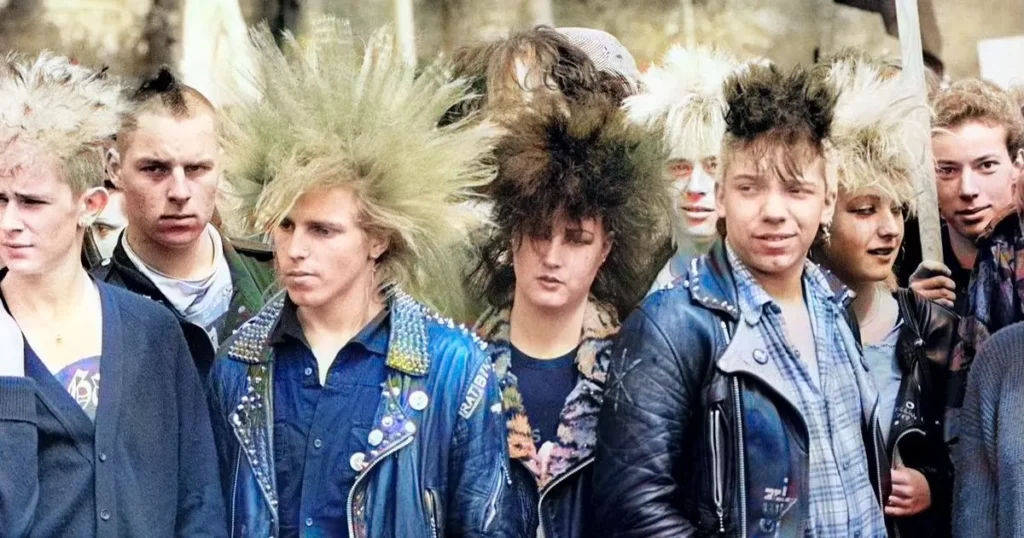
Hair Cycle is a natural hair loss remedy and can help achieve healthy strong hair.
What are the Hair Loss Causes?
There are many causes of hair loss in men and women, including disease, nutritional deficiency, hormone imbalance, and stress. However, by far the most common cause is what is called adrogenetic alopecia. Alopecia is simply the medical term for hair loss. Androgenetic refers to the fact that both a genetic predisposition to balding, and the influence of androgens, or male hormones, play a part in this type of hair loss. There is a third factor, which is the passage of time, or aging. In other words, for androgenetic alopecia to occur, there must be:
- A genetic propensity for balding
- The presence of androgens, or male hormones
- Enough aging time to allow the first two factors to exert their influence on the hair follicles’ genetics
Genetics is not always simple, and such is the case with balding. Just the presence or absence of balding in one’s parents or grandparents, on either the mother’s or father’s side, is not necessarily predictive of one’s likelihood of balding. Certainly, if a man’s father is completely bald, and this man begins to rapidly lose hair in his early twenties, it’s a safe bet that he will develop extensive balding at some point. In short, it’s very hard to accurately predict who will go bald and how rapidly. This inherent uncertainty about the progression of balding is of utmost importance in planning surgical hair restoration, as we will see in later sections. We must always plan for a “worst case scenario” to give patients the best possible results in the long term, as well as in the short term. Anything less is irresponsible.
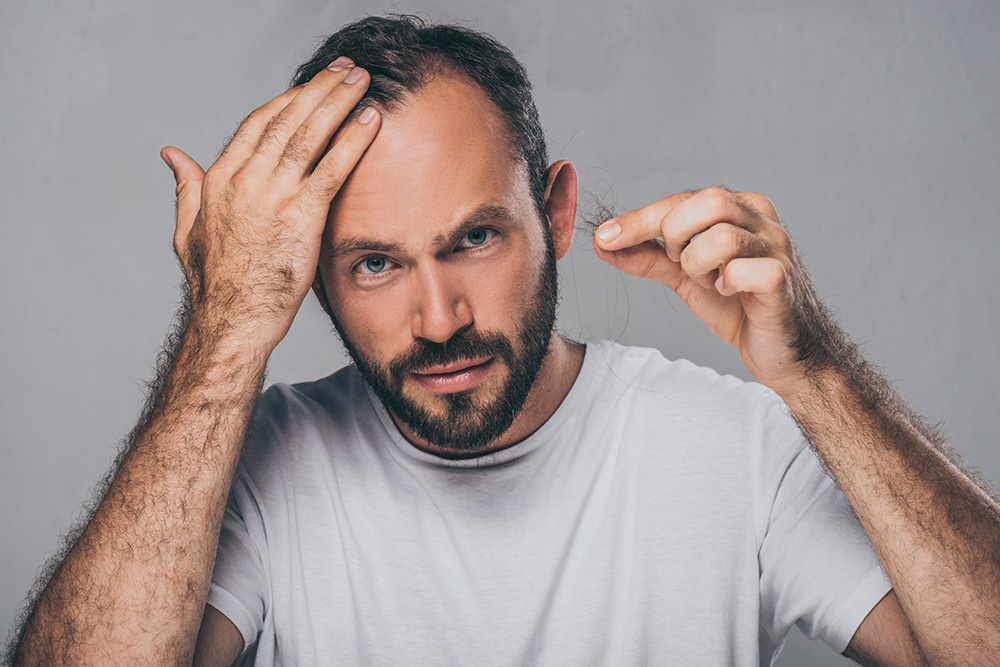
Androgenic Hormones
All normal men and women produce “male” hormones. The most common of these are testosterone, androstenedione, and dihydrotestosterone (DHT). Androgens are produced by the testicles and adrenals in men, and by the ovaries and adrenal glands in women. These hormones are quite important in both sexes, but occur in different concentrations, being much more predominant in males than in females. This, in part, is responsible for the typical differences between the genders. It is the exposure of the hair follicles to DHT, in a genetically susceptible person, over a period, which leads to androgenetic alopecia, or male and female pattern baldness. How does this exposure to DHT occur?
In certain cells of the hair follicle, and the sebaceous glands, there are high levels of an enzyme called 5-alpha-reductase. What this enzyme does is convert testosterone, which is delivered to these areas by the blood, into DHT. This is important not only in understanding the mechanisms of balding but also in one medical treatment now available: Propecia (finasteride). What Propecia does is inhibit, or limit the activity of, this 5-alpha-reductase enzyme. Therefore, there is less conversion of testosterone to DHT, and lower levels of DHT are found in the follicle. In later sections, we will discuss this and other medical treatments in much greater detail.
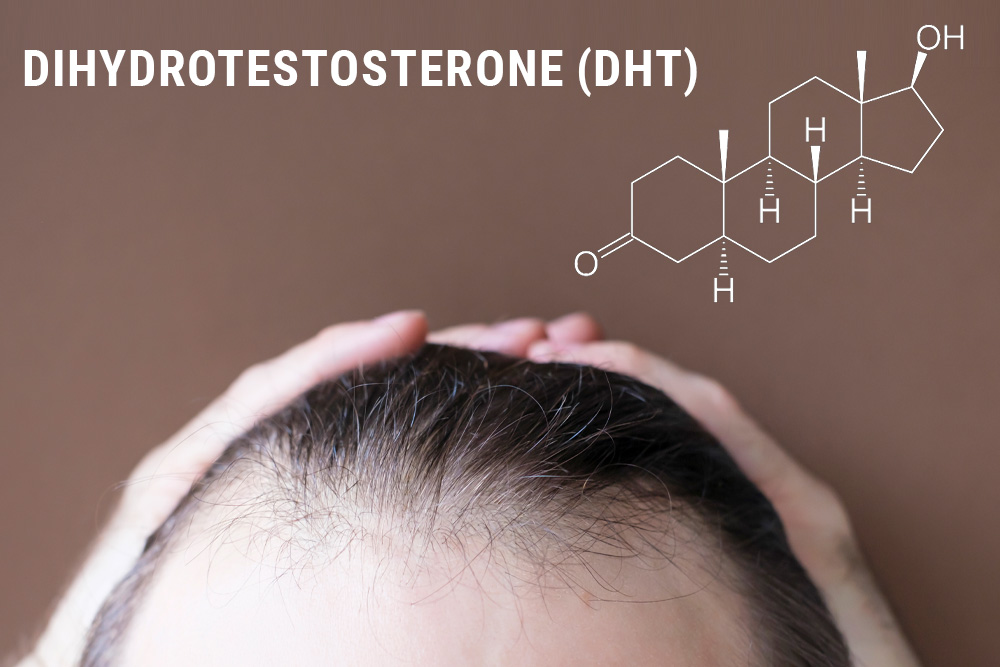
Aging
There is no set age at which balding occurs. It is a process, and this is a simple, but oft-ignored fact. Like any process, it can be rapid or slow, it can begin toward the end of life or in the late teens, and it can progress in a predictably inexorable fashion, or it can stop and start, seemingly stabilize, and then begin again. Once we understand and accept this as a dynamic process, then we can better plan for the present and the future in terms of how we treat it. This quest for understanding, which you have begun just by opening this book, will do more than all the despairing thoughts, hand-wringing, and self-pity, toward allowing a clear-eyed, rational, long-term approach to the problem of hair loss. So we now have looked at these three interdependent factors that play into the common types of balding. Again, they are hormones, genetics, and Father Time. So what exactly does happen to the hair? Let’s take a look. Assuming we have a genetically predisposed person, then as the follicles are continuously exposed to DHT, an interesting phenomenon occurs. Remember the anagen phase or active growth phase of the hair? This phase becomes gradually briefer and briefer, and eventually, the hair becomes finer and shorter, and less deeply colored. We call it the “miniaturization” of hairs. This is also the point at which hair loss tends to first be noticed. It’s not that there are fewer hairs on the head, but that their caliber (cross-sectional area), color, and length are so diminished that they no longer provide “coverage” for the scalp beneath. Light penetrates through to the shiny scalp, and this is perceived by the observer as “thinning” or balding. Also, the ratio between hairs in the anagen phase and those in the telogen, or resting phase, is increased. This simply means that, at any given time, an increased number of hairs are in the telogen phase. These extra numbers of telogen hairs will be found in the susceptible zone for common balding, which is the front, top, and crown of the head. The so-called “permanent” zone, the familiar horseshoe-shaped wreath of hair around the back and sides, is unaffected by these changes. The telogen hairs are easily dislodged during washing, drying, or combing, and this is the second sign of balding: in addition to the apparent thinning seen with miniaturization, we begin to see larger numbers of hairs on the comb, the towel, the pillowcase, or in the bathroom drain. This can be quite traumatic, especially for the younger man or for women. In the next section, we will discuss the natural history of balding, that is, the way it first presents or appears, the different ways it progresses, and how it affects the different regions of the head. For the sake of completeness, let’s briefly mention some of the other patterns of hair loss, if only to distinguish them from androgenetic alopecia (male and female pattern baldness). There is alopecia areata, where discrete patches of the scalp go bald; triangular alopecia, which tends to occur in a triangular pattern in the temporal area; alopecia universalis, in which the entire body may be affected; and various “toxic” alopecias, including those following a severe illness, sometimes with high fever, or following pregnancy. Toxic alopecias may also occur with low thyroid and/or pituitary gland function, or following chemotherapy. The cicatricial (scarring) alopecias occur following tissue destruction and inflammation. Also seen are the so-called diffuse alopecias (patterned and unpatterned), in which there is widespread thinning that may affect the “permanent” zone as well as the areas vulnerable to balding. In any or all of these less common types of balding above, it may be necessary to have a complete physical and laboratory workup, possibly including a scalp biopsy.
So again, the common types of balding are directly related to the presence of male hormones in a genetically predisposed person over time. This can occur in both men and women. The process involves progressive miniaturization of the terminal hairs and diminished length of the active hair growth cycle. Now, let’s take a look at how this microscopic, cellular process is manifested on the head; we can call this the natural history of balding.
Hair Loss in Men
Hair loss occurs in both men and women, but the causes can be divergent. This is quite important because treatment options depend closely on causative factors.
It is normal to shed some hair each day as part of this cycle. However, some people may experience excessive (more than normal) hair loss. Hair loss of this type can affect men, women, and children. Hair Loss has been the most common cause by far is male pattern baldness or androgenetic alopecia. This is the common hair loss pattern that is dependent on genetic predisposition, androgens (male hormones), and the simple passage of time.
These men have increased levels of a hormone known as 5(alpha)-reductase, which transforms testosterone into dihydrotestosterone (DHT). The DHT, in turn, causes follicles to sprout shorter, finer hairs, before eventually dying out. It also causes the growth phases of hair follicles to become shorter, and the other phases to be longer. This usually results in the common Norwood pattern of loss, consisting of hairline recession, with or without loss in the crown.
Sometimes, acute stress to the system (such as high fever, sudden weight loss, etc.) produces a sudden, rapid shedding of hair, where you find clumps of hair coming out all over the place. Although this syndrome (called telogen effluvium) is alarming, it is good news, because the body readjusts itself, and most if not all the hair grows back. People whose loss of hair is inherited notice their hair is thinning but don’t see very much hair coming out.
Most men will lose hair at some point during their lives. Seventy percent of adult males will experience some degree of balding, and advanced male pattern baldness affects well over one-half of the adult male population.
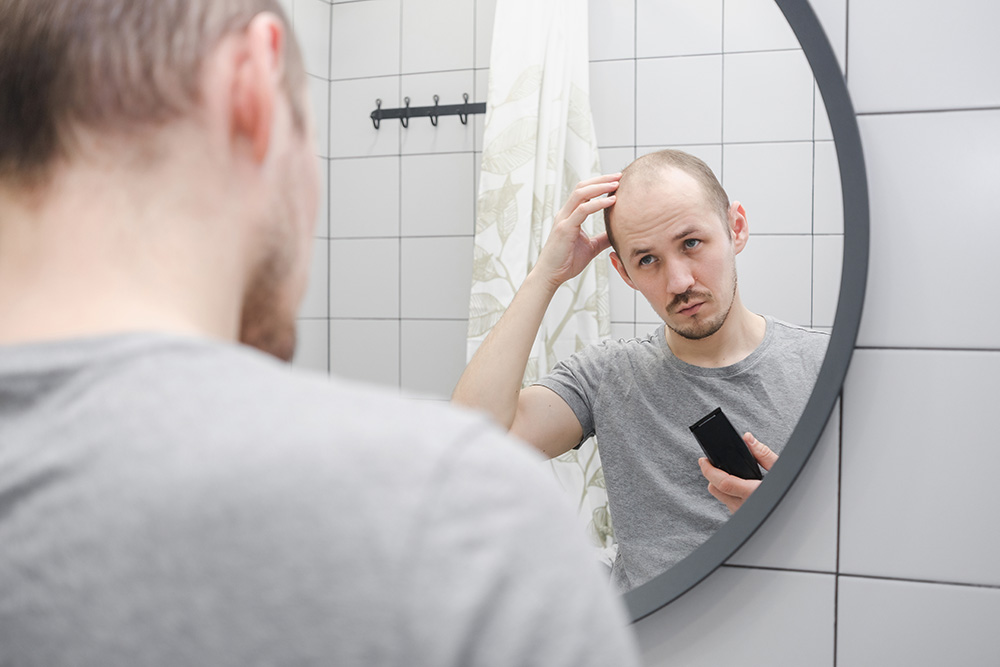
Men who suffer from androgenetic alopecia will experience hair loss at a younger age and until age 60 will lose anywhere between 30-90% of their hair. While boys have a straight low hairline, adult men have more of an “M”-shape.
Male pattern baldness is dependent on the interaction of three factors: age, a genetic predisposition, and male hormones, Once male pattern baldness begins, it does not stop.
The progression of male pattern baldness is generally classified on the Hamilton-Norwood scale, which ranges from stages I to VIII (see example)
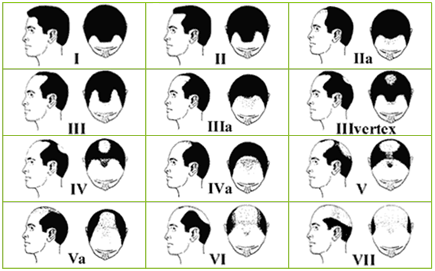
Hair cycle is a natural hair growth stimulator for men.
Hair Loss In Women
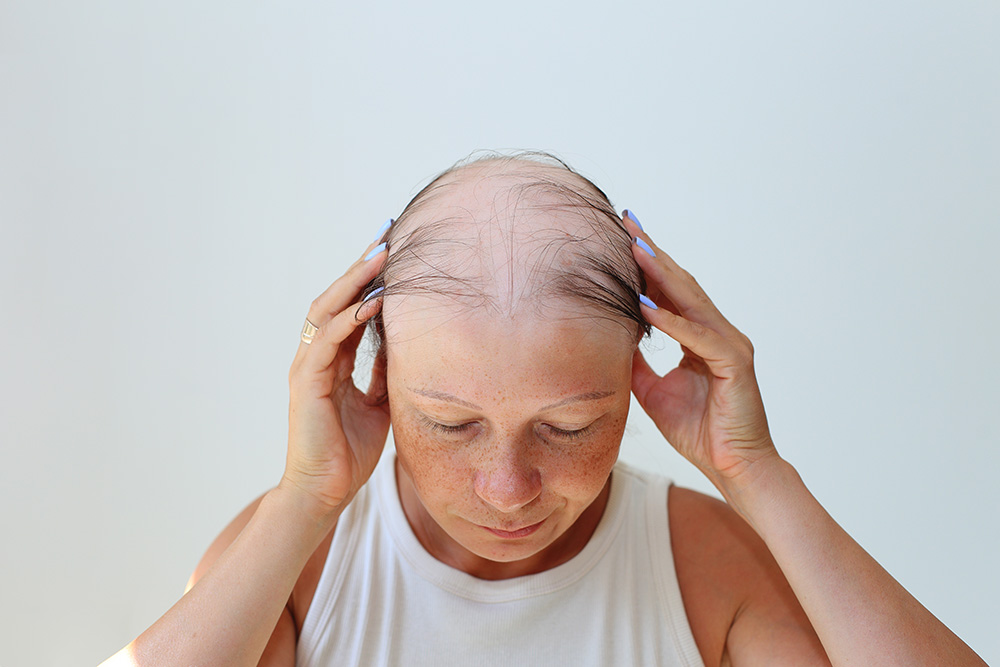
The causes of hair loss in women are much more varied than in men. When a woman presents to a physician with alopecia (hair loss) for the first time, a careful history must be obtained. In other words, the pattern must first be determined. Is the thinning all over? or is it a widening of the part, or a typical “male” pattern of hairline recession? This information suggests to the physician where to direct his physical exam, and if laboratory studies are indicated.
The typical female pattern is the so-called Ludwig pattern, which retains the hairline, but sees the middle part become progressively wider over time; women, however, can also experience the typical Norwood pattern, so common in men. Then the progression must be determined. Did the loss begin suddenly, and was a “rapid “shedding” noted? Or has there been a slow, steady loss over time? Depending on the pattern and progression, the doctor may decide to do microscopic hair exams, together with hair pull or pluck tests, or to order various lab studies.
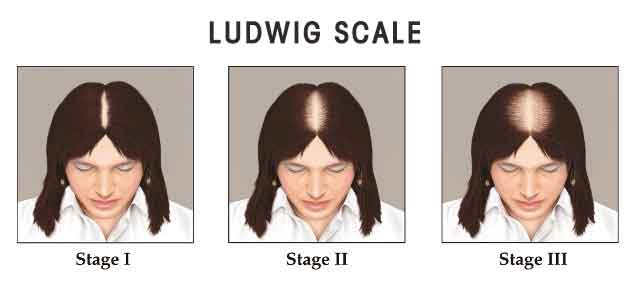
Common systemic conditions that can cause hair loss include anemia, excess androgens, autoimmune disorders, and many, many causes of acute stress, such as surgery, childbirth, fever, severe illness, and extreme psychological stress.
In men, the most common cause by far is male pattern baldness or androgenetic alopecia. This is the common hair loss pattern that is dependent on genetic predisposition, androgens (male hormones), and the simple passage of time. This usually results in the common Norwood pattern of loss, consisting of hairline recession, with or without loss in the crown. It is quite uncommon to find other causes of hair loss in men. The most common treatments for men are medical treatment (Propecia, Rogaine) and surgical treatments (hair transplantation).
Hair cycle is a natural hair growth stimulator for women.
Hair Loss Solutions
Now that we know the causes of hair loss in Androgenetic Alopecia (MPB), we can move to the next step which is evaluating your type of hair loss. You can simply fill out this Contact Form to get diagnosed by a doctor. There are a lot of male myths about balding and hair loss. Let’s explore them before pointing the solutions:
Hair Loss myths
- Men’s baldness comes from the mother’s side- False, it can come from any family relative
- Long hair and hats can cause hair loss-False,
- Using styling products, no hair care product can cause direct hair loss, however using Haircycle Natural Styling Gel can stimulate anagen for a healthy hair environment.
- Shampooing does not accelerate balding; the hairs you find are just the ones ready to come out, and these will be replaced.
- There are no viral infections that cause direct balding. Some powerful medications, however, may be culprits of hair loss since they kill off the hair’s roots. In any case, always consult your physician.
Now, that we know what does and doesn’t cause hair loss, we can review the available options for your treatment.
There are only 5 types of treatments available today:
- DHT Inhibitors
- Stimulant hair in the Anagen phase
- Anti-inflammatory’s
- Antiandrogens
Hair Cycle Products includes all these treatments and more, Hair cycle is natural and contains no alcohol (except the Volume hair spray). The hair cycle is highly effective for the healing process post-hair restoration surgery, A combination of hair cycles during hair transplant is proven to produce superior and better results than any other product on the market. Whatever your goal is, if it’s to have better healthy hair, or just to maintain your hair, Hair Cycle is a safe and natural solution.

